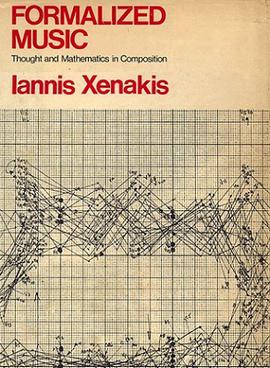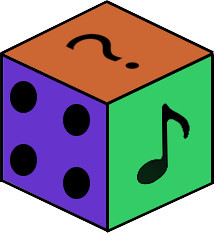
📜 Xenakis, Iannis. 1971. Formalized Music: Thought and Mathematics in Composition. Bloomington: Indiana University Press.
A thorough review of Formalized Music. Thought and Mathematics in Composition would not be an easy task. The book covers many topics, requiring fluency in math, then expecting familiarity with Byzantine musical terminology or providing several dozen pages of source code, all while mixing these dense technicalities with subjective aesthetic preferences. Another matter are the many foresights of then-future developments, where historical changes are hard to factor in; this is especially visible in the topic of computers both as synthesisers and composition tools. There are versions of the text to consider too: the first edition appeared in 1963 and the book was later expanded1.
Large blocks of text refer to music theory, music history or aesthetics, philosophy, and also to details on Xenakis's own work. Somewhat fortunately music game content is contained in coverage. A few general remarks dispersed around the book will be our first focus, and then we'll make a deeper dive into Chapter IV, Musical Strategy that focuses on applications of mathematical game theory to music.
Musical aspects
One of the book fixtures is an abstracted approach to musical parameters. Relatively often the focus turns to timbre, in practice achieved by having lists of available instrumental techniques (classical or extended). Dimensions are favored and simplify plotting graphs, which is a frequent presentation method. Unfortunately, the "parameter theory" is not built.
Every sonic event is perceived as a set of qualities that is modified during its life. On a primary level we perceive pitch, duration, timbre, attack, rugosity, etc. On another level we may distinguish complexities, degrees of order, variabilities, densities, homogeneities, fluctuations, thicknesses, etc. Our study will not attempt to elucidate these questions, which are not only difficult but at this moment secondary. [p. 157-158]
The book acknowledges a few times that many of the presented techniques could be also applied to broader musical structures (closer to a general aspect in our glossary understanding).2'3
On musical culture
A recurring theme in modern music is the composer / performer relationship. The book's position on this topic is not clear-cut, relatively early Xenakis notes (p. 38):
[…] we must speak of the principle of improvisation which caused a furore among the neo-serialists, and which gives them the right, or so they think, to speak of chance, of the aleatory, which they thus introduce into music. They write scores in which certain combinations of sounds may be freely chosen by the interpreter. It is evident that these composers consider the various possible circuits as equivalent. Two logical infirmities are apparent which deny them the right to speak of chance on the one hand and "composition" on the other (composition in the broad sense, that is):
1. The interpreter is a highly conditioned being, so that it is not possible to accept the thesis of unconditioned choice, of an interpreter acting like a roulette game. The martingale betting at Monte Carlo and the procession of suicides should convince anyone of this. We shall return to this.
2. The composer commits an act of resignation when he admits several possible and equivalent circuits. In the name of a "scheme" the problem of choice is betrayed, and it is the interpreter who is promoted to the rank of composer by the composer himself. There is thus a substitution of authors. The extremist extension of this attitude is one which uses graphical signs on a piece of paper which the interpreter reads while improvising the whole. The two infirmities mentioned above are terribly aggravated here.4
The topic shows up also elsewhere when Xenakis critiques an idea of identifying music with the message (#communication vs. #construction?) (p. 180-181). On this occasion, some attitude is shown against intuitive music, graphic scores, happenings, with a main accusation of "taking music outside of itself" while advocating for an increased "confidence in pure music". There might be some misunderstanding here at play; still on the same occasion, Xenakis writes:
Graphical writing, whether it be symbolic, as in traditional notation, geometric, or numerical, should be no more than an image that is as faithful as possible to all the instructions the composer gives to the orchestra or to the machine.
…seemingly staying oblivious to the fact that such a power dynamics is itself a factor staying outside of music. But there is yet another fragment, delivered when analyzing Terrêtektorh — Xenakis's spatial work where instruments are dispersed through the whole music hall. This remark from page 237 was, contrary to statements above, not present in the first edition of the book, and may be (??) a sign that author's sensibility towards individual performance grew with time:
[Terrêtektorh] puts the sound and the music all around the listener and close up to him. It tears down the psychological and auditive curtain that separates him from the players when positioned far off on a pedestal, itself frequently enough placed inside a box. The orchestral musician rediscovers his responsibility as an artist, as an individual.
Before we dive, a few additional topics…
Logical playing: A lesser line of thought to follow is in the chapter Symbolic Music which goes through the process of representing logical relations in musical terms. One of the conclusion of that elaborate construction is: "we can reason by pinning down our thoughts by the means of sound" (p. 172) and this is an extremely interesting statement.
Mosaic of coherences: The Preface presents a table, supposedly for explaining the relations between parts of the book. It's hard to grasp it before reading, and in general the lecture may easily come off quite disjointed. From the perspective of final pages though, the whole text seems to be guided by an interestingly singular approach despite making huge leaps around many topics.
General playfulness: Nope. None. But in honesty, it's not an accusation. The seriousness of the read comes not only from heavy terminology or operating at a high level of abstraction but also from deep expectations of art in general. And such a reveal might be reinterpreted as an utmost enthusiasm for music…
Musical Strategy — Strategy, Linear Programming, and Musical Composition
Heteronomous Music — Music with an external conflict introduced.
Chapter IV is the shortest in the book and focuses exclusively on games. Firstly, with the ongoing purpose to look for new horizons in music, Xenakis introduces the notion of heteronomous music. To tackle that topic, the book's go-to method is mathematics, so Xenakis proceeds to set up game-theoretical framework. [Here, if you are not familiar with mathematical game theory, consider taking a detour through Math for Music Games for the basics (coming soon, video included).]
After introducing another term, degenerate game, in which the parties play arbitrarily following a more or less improvised route, without any conditioning for conflict, the chapter focuses on the mathematics of two pieces: Duel (1959) and Stratégie (1962). And here, from gaming perspective at least, there will be some problems. Firstly it is noticed:
In the field of calculation the problem of games is rapidly becoming difficult, and not all games have received adequate mathematical clarification, for example, games for several players. We shall therefore confine ourselves to a relatively simple case, that of the two-person zero-sum game.
The starting matrix is introduced, then made asymmetrical. After that, considerable amount of paper serves calculations, which seem a bit like a pointless exercise. Xenakis transforms the matrix to arrive at a fair game (irrelevant both for analysis and for gameplay — an "aesthetic choice" probably), but after all, settles for… approximate values (a surprise that is laudable design-wise). Finally we will arrive at a nice:
| -1 | +1 | +3 | -1 | +1 | -1 |
| +1 | -1 | -1 | -1 | +1 | -1 |
| +3 | -1 | -3 | +5 | +1 | -3 |
| -1 | +3 | +3 | -1 | -1 | -1 |
| +1 | -1 | +1 | +1 | -1 | -1 |
| -1 | -1 | -3 | -1 | -1 | +3 |
In the meantime, another piece of math is a basic analysis for such a game and calculating mixed strategies for players. And now comes the twist, because it occurs that it's not a usual game of simultaneous choice but the players-conductors are supposed to choose their strategies one after another iteratively and payments accumulate toward the final score. For such a full-information game estimating the mixed strategy doesn't make sense as there should be an optimal strategy (although finding it would require even more computation).
Anyway, as we see in the matrix, Duel has six available strategies for each player, these are fully notated in the score (not included in the book), the strategies may be characterized as:
Event I: A cluster of sonic grains such as pizzicati, blows with the wooden part of the bow, and very brief arco sounds distributed stochastically.
Event II: Parallel sustained strings with fluctuations.
Event III: Networks of intertwined string glissandi.
Event IV: Stochastic percussion sounds.
Event V: Stochastic wind instrument sounds.
Event VI: Silence.
The second game, Stratégie has 19 available strategies (some combined from simpler ones) and is generally treated with less of numerical detail. Xenakis proposes a few options on limits of the game and on methods of resolving minor issues. There is an interesting conversion of a big matrix to a set of smaller ones (may be used optionally) but it's not a major simplification of use.
Summary
This review touches on a few ideas from the book full of them and hopefully this is a subset the most interesting for the music gaming community. All in all, Xenakis's approach has limitations coming both from the compositional tradition and from mathematical game theory itself, which is not great to use with actual games. There is more inspiration for game design from non-zero-sum games, which are not considered in the work. But the pioneering deed of introducing conflict into the tradition of "art music" is a fantastic achievement.

If you think anything should be added to this subpage, please drop a hint or a link for future editors.
